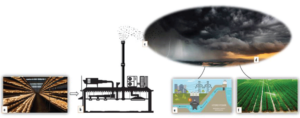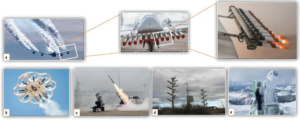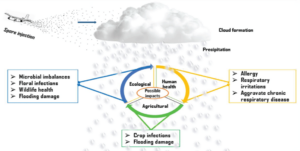Atmospheric Fungal Spore Injection: A Promising Breakthrough for Challenging the Impacts of Climate Change Through Cloud Seeding and Weather Modification
Introduction: The Role of Atmospheric Science in Addressing Climate Challenges
The pressing challenges of climate change have placed atmospheric science at the forefront of innovation. This field has revolutionized our understanding of the planet’s weather systems and offered cutting-edge solutions to combat environmental crises. One promising development is atmospheric fungal spore injection, an innovative approach to cloud seeding and weather modification. By leveraging biological ice-nucleating particles (INPs), researchers aim to address water scarcity, enhance agricultural productivity, and mitigate urban heat, all while prioritizing sustainability and ecological balance.
Learn more about atmospheric fungal spore injection here.
Understanding the Science of Cloud Seeding and Atmospheric Fungal Spores
What is Cloud Seeding?
Cloud seeding involves introducing substances like silver iodide or dry ice into clouds to stimulate precipitation. This technology, used for over six decades, helps regions combat drought, support agriculture, and manage water supplies. Traditional cloud seeding relies on synthetic chemicals, which raise concerns about environmental impact. Recent advancements in atmospheric science suggest that fungal spores—natural, abundant, and biodegradable—offer a promising alternative.
Discover more about cloud seeding techniques and their impact in the PDF document.
Why Fungal Spores?
Fungal spores, prevalent in the atmosphere, act as cloud condensation nuclei (CCN) or ice nucleators (INPs). Their unique hydrophilic properties make them ideal for forming ice crystals in clouds, which then lead to precipitation. Unlike synthetic chemicals, fungal spores are eco-friendly, reducing potential harm to ecosystems and human health.
Key fungal classes such as Agaricomycetes, Dothideomycetes, and Ustilaginomycetes have shown remarkable nucleating abilities, making them central to this emerging technology.
Read about specific fungal classes and their nucleating capabilities.
 Figure 1: Hypothetical ground-based fungal spore launching for cloud seeding purpose: macro-scale indoor fungal cultivation (a), cultivation room equipped with an air blower, air sucking, and generating machines (b), spore dispersal through a plumbing vent (c), fungal spores induces and enhances precipitation (d), dams collect sufficient water thereby maximizing hydropower generation (e) and agricultural productivity (f). (Source: https://mushroom-growing.com/indoor-mushroom-farm/ (a), https://www.istockphoto.com/de/vektor/zentrale-klimaanlage-für-gebäude-gm113015 560 4-298811431 (b), https://www.istockphoto.com/de/fotos/heavy-rain-in-the-mountains (d), , (e) https://home.howstuffworks. com/ irrigation.htm (f))
Figure 1: Hypothetical ground-based fungal spore launching for cloud seeding purpose: macro-scale indoor fungal cultivation (a), cultivation room equipped with an air blower, air sucking, and generating machines (b), spore dispersal through a plumbing vent (c), fungal spores induces and enhances precipitation (d), dams collect sufficient water thereby maximizing hydropower generation (e) and agricultural productivity (f). (Source: https://mushroom-growing.com/indoor-mushroom-farm/ (a), https://www.istockphoto.com/de/vektor/zentrale-klimaanlage-für-gebäude-gm113015 560 4-298811431 (b), https://www.istockphoto.com/de/fotos/heavy-rain-in-the-mountains (d), , (e) https://home.howstuffworks. com/ irrigation.htm (f))
 Figure 2: Mechanisms of launching INPs; aircraft deployment (a), drone-based dispersal (b), rocket-based INPs injection (d), automated high-output ground seeding system (AHOGS) (d), ground-based cloud-seeding generator (e). (Sources: https://www.bibalex.org/SCIplanet/en/Article/Details.aspx?id=128, (a), (b), https://x.com/wulei2020/status/1530456011244380160 (c),https://www.scientificamerican.com/ article/drought -ridden-l-a-tries-rainmakers-to-tap-storm-clouds/ (d), ) (e))
Figure 2: Mechanisms of launching INPs; aircraft deployment (a), drone-based dispersal (b), rocket-based INPs injection (d), automated high-output ground seeding system (AHOGS) (d), ground-based cloud-seeding generator (e). (Sources: https://www.bibalex.org/SCIplanet/en/Article/Details.aspx?id=128, (a), (b), https://x.com/wulei2020/status/1530456011244380160 (c),https://www.scientificamerican.com/ article/drought -ridden-l-a-tries-rainmakers-to-tap-storm-clouds/ (d), ) (e))
 Figure 3: Possible impacts of using fungal spores as ice nucleating agents for cloud seeding and weather modification operations.
Figure 3: Possible impacts of using fungal spores as ice nucleating agents for cloud seeding and weather modification operations.
Applications of Atmospheric Fungal Spore Injection
- Agricultural Productivity: By enhancing rainfall in drought-prone areas, fungal spore injection can support farmers and stabilize food security.
- Urban Heat Reduction: Increased cloud cover can lower temperatures in urban regions, offering relief from heatwaves.
- Water Management: This technology ensures a consistent water supply for hydropower generation and human consumption.
- Climate Cooling: Marine cloud brightening, achieved by dispersing fungal spores over oceans, enhances solar reflectivity and contributes to atmospheric cooling.
Explore these applications in detail in the PDF report.
Atmospheric Science in Action: How Fungal Spore Injection Works
The process begins with cultivating fungal spores in controlled environments. These spores are then dispersed into the atmosphere using aircraft, drones, or ground-based systems. Once in the atmosphere, they interact with water vapor to form ice crystals, which eventually fall as rain or snow.
This detailed infographic in the HTML version of the article illustrates the mechanism.
Challenges and Ethical Considerations
Health and Ecosystem Risks
High concentrations of fungal spores may trigger respiratory issues, especially for those with asthma or allergies. Furthermore, altering natural atmospheric conditions could have unintended consequences for ecosystems, disrupting soil microbial diversity and agriculture.
Geopolitical and Ethical Concerns
Manipulating weather systems can inadvertently affect neighboring regions, sparking conflicts over resource allocation. Additionally, ethical concerns about tampering with nature remain a significant barrier to widespread adoption.
Address these ethical considerations in-depth here.
Integrating Robotics for Precision and Efficiency
The intersection of robotics and atmospheric science has enabled precise spore delivery systems. Drones equipped with dispersal mechanisms ensure targeted applications in remote areas, maximizing efficiency and minimizing waste.
Read about advancements in robotic delivery systems in the PDF document.
The Future of Atmospheric Science and Geoengineering
The potential of fungal spore injection is vast, but it requires further research and collaboration. Key areas for development include:
- Optimizing Fungal Strains: Identifying species with superior nucleation capabilities.
- Enhancing Delivery Mechanisms: Developing cost-effective, scalable systems for spore dispersion.
- Global Collaboration: Establishing international guidelines to address ethical and environmental concerns.
Conclusion: Unlocking the Power of Atmospheric Science
The integration of atmospheric science and biotechnology
exemplifies humanity’s innovative spirit in tackling climate challenges.
Atmospheric fungal spore injection stands as a testament to the potential of
natural solutions amplified by cutting-edge technology. By embracing this
promising method responsibly, we can pave the way for a sustainable and
resilient future.
